It happened so quickly. The light was red and the traffic was stopped. Then the SUV rear-ended you. The headaches and dizziness are constant and have not responded to care. Your doctor is puzzled as all your tests are normal. What is Craniocervical Instability – or Cranial Cervical Instability? What is the Alar Ligament? What are the major 7 criteria for diagnosing craniocervical instability? What is the PICL procedure? Let’s dig in.
What Is Cranial-Cervical Instability (CCI)?
Cranial Cervical Instability (CCI) is a medical condition where the strong ligaments that hold your head to your upper neck are loose or lax (1). The major ligaments involved are the Alar, Transverse and Accessory ligaments. To learn more about CCI please click on the video below.
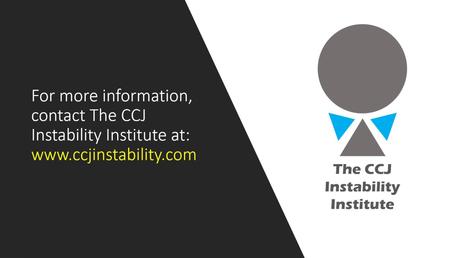
What Is the Alar Ligament?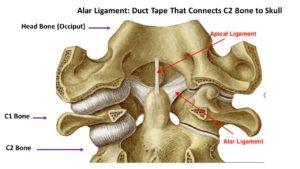

Ligaments are thick bands of connective tissue that connect one bone to another. The Alar ligament connects the upper neck to your head. There is a right and a left Alar ligament which is illustrated to the right. The Alar ligament provides stability for your head and neck.
Diagnosing Cranial-Cervical Instability: 7 Main Criteria
The correct diagnosis is critical for the best clinical outcome. Diagnosing craniocervical instability involves 7 main criteria which include:
Mechanism of Injury (How Did It Occur)
Understanding how and when the injury occurred is important. The two most common causes of Cranial Cervical Instability (CCI) are trauma and medical conditions that cause people to have loose or compromised ligaments (2). Motor vehicle accidents, contact sports, and forceful manipulations by chiropractors are the most common examples of trauma. Ehlers Danlos Syndrome (EDS) is a group of inherited disorders that affect your ligaments and connective tissues (2).
Symptoms
The symptoms associated with CCI can be extensive depending upon the severity of the instability. The most common symptoms include:
Headaches

This is not your normal headache caused by your in-laws or excessive consumption of alcohol. This is a debilitating headache that is constant in duration and miserable.
Upper Neck Pain
Pain is typically localized at the base of the skull and aggravated with flexion and rotation. The pain can shoot up into the base of the skull, top of the head, or behind the eyes.
Dizziness
Balance disturbances vary in severity and can make a simple walk down the hall almost impossible at times.
Visual Disturbances
Loss of visual acuity, blurred vision, and changes in peripheral vision can be some of the symptoms in patients with CCI (3).

Brain Fog
Patients with CCI can struggle with memory, concentration, and ability to complete tasks. Every day can feel like your brain is stuffed full of cotton.
Physical Examination
In the age of managed care and 15-minute appointments, the art and practice of physical examination by a physician is almost gone. At the Centeno -Schultz Clinic all new patient evaluations undergo an extensive physical examination. Why? It is important to view the body as a whole and there are multiple potential physical findings in the neck, head, shoulder, and low back in patients with cranial cervical instability,
Radiographic Studies
There are various types of radiographic studies which include x-ray, CT scan, and MRI. Unfortunately, traditional MRI and CT studies do not evaluate the upper cervical spine or alar and transverse ligaments. Special radiographic studies are required which include upper cervical MRI or rotatory CT scan. In addition, there are additional studies that involve the patient moving during the examination. These studies are useful to identify instability. Examples include upright MRI with upright flexion/extension. to see how this works please click on the video below.
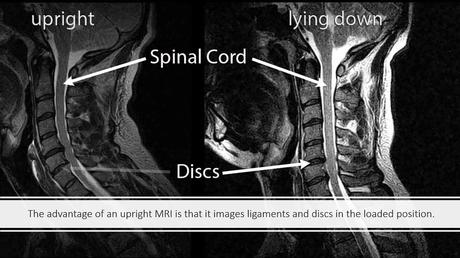
Finally, a Digital Motion X-ray (DMX) is important in establishing the diagnosis of CCI. This is an x-ray examination that is recorded in which the patient is put through various movements including bending the neck forward, backward, and to the side. To learn more about DMX please click on the video below.
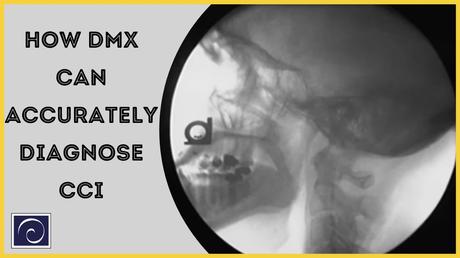
Response to Conservative Care
The common symptoms of CCI can also arise from different clinical conditions. For example, headaches with dizziness may arise from tight or contracted neck muscles. It is important that patients undergo conservative care such as rest, heat, stretching, physical therapy, massage, and chiropractic care. In some cases, symptoms improve with conservative therapy.
Response to Diagnostic Injections
A diagnostic injection is a precise injection into a specific structure asking the question of whether or not it resolved the pain. Often times this is very helpful in the evaluation of patients with CCI. All diagnostic injections are performed under ultrasound or x-ray or both. Examples of diagnostic injections include:
- C0-1 and C1/2 facet injections
- Occipital nerve blocks
- Superficial Cervical Plexus Blocks
- Ligament injections
Level of Disability
In many cases due to the severity of the symptoms patients are not able to complete their domestic or professional responsibilities. In severe cases of CCI, patients are confined to their homes and are socially isolated. The level of disability is important in diagnosing craniocervical instability (CCI).
Percutaneous Implantation of Cervical Ligaments Procedure – The “PICL”
In 2015 a nonsurgical treatment option for cranial cervical instability was developed at the Centeno-Schultz Clinic. It involves the injection of a patient’s own bone marrow-derived stem cells into the damaged alar, transverse ligaments. The procedure is very demanding and only performed at the Centeno-Schultz Clinic in Broomfield Colorado. The procedure is called Percutaneous Implantation of Cervical Ligaments (PICL) To learn more about this groundbreaking procedure please click on the video below.
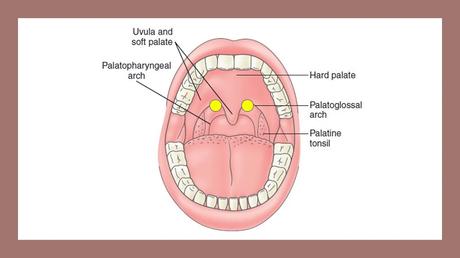
In Conclusion
Cranial Cervical Instability (CCI) is a medical condition where the strong ligaments that hold your head to your upper neck are loose or lax. The 7 criteria used in diagnosing craniocervical instability include the mechanism of injury, symptoms, findings on physical examination, radiographic studies, response to conservative care and diagnostic injections, and level of disability. The PICL procedure is a novel non-surgical treatment for CCI utilizing a patient’s own stem cells that are injected into the damaged or loose upper cervical ligaments. The procedure allows patients to avoid the serious risks and complications associated with surgery.
If you or a loved one sustained an injury and have symptoms that include headache, dizziness, and brain fog which is unresponsive to conservative care you may have cranial cervical instability. Schedule an in-office or telemedicine consultation with a board-certified, fellowship-trained physician to determine if the criteria for cranial cervical instabillity are met. Act now before the injury and symptoms progress which limits your options.
1.Offiah CE, Day E. The craniocervical junction: embryology, anatomy, biomechanics and imaging in blunt trauma. Insights Imaging. 2017;8(1):29–47. doi:10.1007/s13244-016-0530-5
2.Sobey G. Ehlers-Danlos syndrome – a commonly misunderstood group of conditions. Clin Med (Lond). 2014;14(4):432-436. doi:10.7861/clinmedicine.14-4-432
3.Ischebeck BK, de Vries J, Van der Geest JN, et al. Eye movements in patients with Whiplash Associated Disorders: a systematic review. BMC Musculoskelet Disord. 2016;17(1):441. Published 2016 Oct 21. doi:10.1186/s12891-016-1284-4

